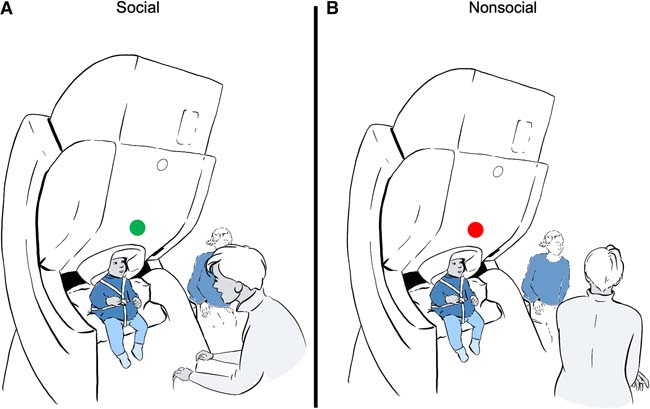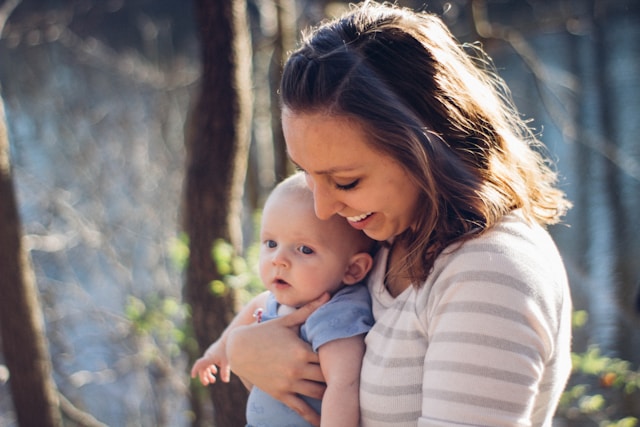Researchers at the University of Washington found that when an adult spoke and socially played with a five-month-old baby, the baby´s brain activity increased, particularly in regions responsible for attention. The level of this brain activity predicted greater language development at later ages.
In face-to-face interactions with babies, adults display a species-specific communicative signal. They present a distinctive "social set": they use baby-directed speech (parentese), respond contingently to the babies´ actions and vocalizations, and react positively with mutual gaze and smiles. Studies suggest that this social set is essential for early language learning. Our hypothesis is that the social set engages the attention systems towards speech, and the sensory-motor systems prepare babies to respond vocally, both of which promote language learning.
Using infant magnetoencephalography (MEG), we measured the neural responses of five-month-old babies during face-to-face (F2F) verbal interaction with an adult (social condition) and during a control (non-social condition) where the adult turned away from the baby to talk to another person. Using a longitudinal design, we tested whether the babies´ brain responses to these conditions at five months predicted their language growth at five future points in time. The brain areas involved in attention (right inferior frontal hemisphere, right superior temporal hemisphere, and right inferior parietal hemisphere) showed significantly greater theta activity in the social condition versus the non-social condition. We found that the babies´ neural activity in response to F2F interaction in the attentional and sensory-motor regions significantly predicted future language development in the third year of life, more than two years after the initial measurements. We developed a view of early language acquisition that emphasizes the centrality of the social set and offers new insights into the neurobiological components linking babies´ language learning to early brain functioning during social interaction.

Figure: A five-month-old baby in a MEG brain imaging device with social versus non-social conditions. (A) During the social condition, the experimenter, indicated by a green light, interacted with the baby, exhibiting the social set of behaviors. (B) During the non-social condition, the experimenter, indicated by a red light, turned 45 degrees towards an adult sitting out of the baby’s view and spoke to them. For each baby, the conditions were presented randomly and separated by at least 7 seconds, with a minimum of 16 repetitions for each condition per baby. The recording session lasted about 13 minutes.
Parent-baby interaction is a universal and touching scene. The parent speaks in a high-pitched voice, known as "parentese," while responding positively to the baby´s babbles and gestures, often with eye contact and smiles.
These connections not only create a heartwarming scene. New research from the University of Washington’s Institute for Learning & Brain Sciences (I-LABS) shows they are also crucial for infant language growth.
In a study published in Current Biology, researchers used a safe and non-invasive brain imaging technique called magnetoencephalography, or MEG, to monitor infant brain activity during social and non-social interactions with the same adult. They discovered that when the adult spoke and socially played with a five-month-old baby, the baby’s brain activity increased, especially in regions responsible for attention, and this level of activity predicted greater language development at later ages. This "social" scenario was compared to a "non-social" one in which the adult turned away from the baby to speak to someone else. This interaction showed lower activity levels in the same brain areas.
"This is the first study to directly compare infant brain responses to social interaction between an adult and a baby versus non-social interaction, and then follow up with the children until they are 2.5 years old to see how early brain activation relates to future language skills," said lead author Alexis Bosseler, a research scientist at I-LABS.
The MEG brain imaging technology allowed the baby to move and interact naturally with the adult, enabling researchers to track the activation of neurons in multiple areas of the baby´s brain while the adult spoke, played, and smiled. They then monitored the baby´s brain activity a second time as the adult turned and focused on another person.
These actions occur naturally every day between adults and babies, and the study showed they have different measurable effects on a baby’s brain. The researchers found that increased neuronal activity in response to social interaction at five months predicted greater language development at five later ages: 18, 21, 24, 27, and 30 months. The researchers tracked the babies’ language development using a well-documented and validated survey that asks parents about the words and sentences their babies say at home.
"The connection between early brain reactions and later language is consistent with scientists’ fascination with early age periods and opens many new questions that we and others will explore," said co-author Andrew Meltzoff, I-LABS co-director and professor of psychology at the University of Washington.
The researchers chose five-month-old babies for the study because that age is just before the "sensitive period" for speech and language learning, which begins around six months. Once this period starts, it becomes especially important for babies to observe adults, as attention enhances learning.
Using parentese with babies represents an intuitive desire to connect, said Patricia Kuhl, senior author and co-director of I-LABS.
"There is an implicit understanding that language is about connection," said Kuhl. "It’s a communicative pathway between you and the other person. This begins in infancy with the desire to establish that communicative connection." It’s especially important for parents and early childhood educators to understand the study’s findings, Kuhl said.
"We knew from previous work that social interaction is essential at 9 months of age for learning a foreign language, but the current study shows that social interaction plays a role much earlier," Kuhl said. "The study shows that parents´ natural use of parentese, along with smiles, touch, and their warm back-and-forth responses to their baby´s actions, have a measurable real-world impact on the baby´s brain. We theorize that this parental behavior, which we call the ‘social set,’ captures and holds babies´ attention and motivates them to learn at a critical time in development."
Reference:
Alexis N. Bosseler, Andrew N. Meltzoff, Steven Bierer, Elizabeth Huber, Julia C. Mizrahi, Eric Larson, Yaara Endevelt-Shapira, Samu Taulu, Patricia K. Kuhl. Infants’ brain responses to social interaction predict future language growth. Current Biology, 2024; DOI: 10.1016/j.cub.2024.03.020
















